What is a cerebral vascular aneurysm?
A cerebral vascular aneurysm is a pathological, different in shape and length local protrusion of the vessel wall of the brain. The disease most often affects the vessels within which blood flows under high pressure. Such changes in the vessel wall leading to its increase in size. The protrusion begins to compress the surrounding brain structures, disrupting the functions of the central nervous system.
The described pathology is dangerous for the patient due to the high risk of rupture of the aneurysm with hemorrhage into the brain tissue, in the form of hemorrhagic stroke or subarachnoid hemorrhage.
What is the current problem today?
Vascular aneurysms of the brain are a "slow-acting bomb", as the risk of rupture of the vessel wall is extremely high.
The disease affects 100 people per 1,000,000 population. From 600 thousand to 2 million inhabitants of Ukraine have aneurysms, about 4-12 thousand aneurysms rupture annually. Aneurysm of the vessels of the brain affects people of working age (most often occurs between the ages of 30 and 50 years). Women face this problem twice as often as men.
The problem is often asymptomatic in the early stages of its development, which significantly complicates timely diagnosis. The asymptomatic course of the disease is sometimes detected by accident during a preventive examination.
If there are signs of the disease, you need to seek specialized help immediately !!!
What are the causes of brain aneurysms?
There is currently no single theory of the origin of aneurysms. However, cerebral vascular aneurysms can be congenital or acquired. In the first case, the disease occurs against the background of an existing abnormality in the development of one of the walls of the artery. This can damage the inner lining of the vessel with the formation of a protrusion even at a young age.
In addition to heredity, the development is influenced by the following factors:
- high blood pressure;
- atherosclerosis (calcification of blood vessels);
- head injuries;
- age from 50 years and older;
- alcohol and drug abuse;
- diseases of the circulatory system;
- low estrogen levels after menopause;
- smoking (contributes to atherosclerosis, raises blood pressure).
Provoking factors of the disease are constant stress and severe physical exertion. They cause an increase in pressure in the vessels of the head, increasing the risk of mechanical damage.
The presence of bad habits, smoking, and alcohol abuse, increases the risk of developing aneurysms several times.
What does a cerebral vascular aneurysm consist of?
In an aneurysm allocate a neck, a body, and a dome. The neck of the aneurysm retains the three-layer structure of the vascular wall, so it is the strongest part of the aneurysm, while the dome is represented by only one layer of connective tissue, so the aneurysm wall in this part is the thinnest and most prone to rupture.
Types of cerebral vascular aneurysms
The first classification of pathology is based on its form:
- Saccular aneurysm - is most common among cases of an aneurysm in the brain.
- Aortic dissection - the formation has an elongated shape and is located between the layers of the vessel wall, in the vessels of the brain pathology is much less common than in the aorta.
- Spindle-shaped aneurysm - rare in cerebral vessels, develops mainly on the aortic wall. Formation of a cylindrical shape, the vascular wall expands evenly.
Depending on the size of the protrusion are:
- billion (up to 3 mm in diameter);
- normal size (up to 15 mm);
- large (up to 25 mm);
- giant (more than 25 mm).
The larger the aneurysm, the stronger it compresses the brain tissue and causes a more pronounced neurological picture. Protrusions can also be single- or multi-chambered, single or multiple, congenital or acquired.
What are the symptoms of a cerebral vascular aneurysm?
The danger of an aneurysm of the arterial wall lies in their "quiet" development. In the early stages, a person may not even realize that there is a serious problem, because small aneurysms do not compress the brain tissue and do not cause discomfort.
The clinical picture is manifested in the later stages of the disease. It is worth paying attention to the first signals of problems, which may be:
- visual disturbances, pain in the eyes and head;
- change in motor functions of the extremities - the patient may suddenly "forget" to hold a spoon or his handwriting deteriorates sharply;
- violation of tactile and pain sensitivity of the legs;
- seizures;
- numbness of the facial muscles, inability to smile, sudden violation of diction.
These signs indicate compression of brain tissue. A neurological deficit is developing, which should be the first signal and an urgent reason to seek help from specialists in the medical network of Dobrobut clinics in Kyiv.
If the disease progresses, the aneurysm may rupture. This condition is already life-threatening. Pay attention to the symptoms:
- intense headache, which is difficult to correct with medication;
- photophobia;
- nausea vomiting;
- double vision;
- loss of consciousness;
- intense convulsions.
If a person develops the above symptoms, an ambulance should be called immediately. If necessary, the patient will be taken to the specialists of the Medical Center "Dobrobut" for emergency highly specialized neurosurgical care.
How is a cerebral vascular aneurysm diagnosed?
The main diagnostic measures that are carried out during the examination are:
- palpation, examination of the skin;
- blood pressure measurement;
- neurological examination, which includes: assessment of muscle tone, reflexes, test movements to assess the nervous system.
To detect an aneurysm, a neurologist may prescribe the following instrumental diagnostic methods:
- computed tomography (CT) - the procedure is often used to determine the rupture of a vessel that has already occurred with a hemorrhage in the brain tissue;
- magnetic resonance imaging (MRI);
- angiography of cerebral vessels - the method allows you to assess the size, location, and structure of the aneurysm.
If a subarachnoid rupture of the aneurysm is suspected, the neurologist will also perform a lumbar puncture to assess the condition of the cerebrospinal fluid.
The cost of the examination in Kyiv can be found by calling the call center or on the clinic's website.
When is surgery for a cerebral vascular aneurysm indicated?
- if the size of the aneurysm is 7 mm or more;
- nonspherical (irregular) shape and the presence of diverticula;
- in the presence of a large aneurysm and a narrow neck;
- the size of the aneurysm exceeds the diameter of the vessel to which the aneurysm is attached;
- the appearance of new clinical manifestations (symptoms of cranial nerve damage, the appearance and/or change in the nature of the headache, ischemic disorders in the pool of the artery carrying the aneurysm);
- if there is an increase in the size of the aneurysm by 1 mm or more during the last 6 months;
- bones, cranial nerves, arteries, and veins;
- multiple aneurysms;
- if there is a history of hemorrhage from another aneurysm;
- if there are favorable factors such as smoking and hypertension.
Asymptomatic aneurysms up to 7 mm in size are not treated, as the risk of surgery is greater than the consequences of bleeding (waiting tactics are chosen here). At the same time, the patient is under constant supervision (dynamic supervision with repeated inspections in 6, 12 months, and then every 2 years is necessary). Patients who have refused surgical treatment are subject to similar supervision.
A comprehensive approach to the treatment of cerebral vascular aneurysms
A cerebral vascular aneurysm is a very serious medical problem that requires a comprehensive approach to treatment.
A neurologist or neurosurgeon at Dobrobut Medical Center assesses the risk factors that primarily affect the patient. Based on the collected information, the specialist prescribes drugs that have a better effect on the mechanisms of a secondary aneurysm and help stabilize the patient's condition.
In all cases where there is a possibility, to prevent rupture of the aneurysm, radical treatment is performed - planned surgery. Emergency intervention is indicated when the aneurysm ruptures.
Conservative therapy
Within this direction are most often used:
- analgesics;
- antihypertensive drugs to control blood pressure;
- anticonvulsants;
- means for lowering the concentration of cholesterol in the blood.
Treatment of cerebral vascular aneurysm depends on its size and location, symptoms, and general condition of the patient. The goal of therapy is to prevent possible bleeding.
Note that conservative therapy only complements the surgery and helps prevent recurrence in the presence of risk factors !!!
What types of surgery are performed for cerebral aneurysms?
The best treatment for an aneurysm is to remove it from the bloodstream surgically. This eliminates the risk of ruptures and adverse effects on the nervous system. The choice of a specific treatment option depends on the individual characteristics of each clinical case.
The neurosurgeon distinguishes two standard options of therapy:
- Clipping an aneurysm (clipping) is an open operation in which the affected part of the vessel is closed with a clamp. The effectiveness of the operation is proven, but it has a long recovery period.
- Endovascular aneurysm embolization is a minimally invasive procedure, without incisions, with a minimal rehabilitation period. The operation is performed by inserting a special "wire" into the affected vessel, which blocks the blood supply to the formed bag.
Endovascular methods have a number of advantages. They are minimally invasive, involve minimal risk, and often do not require general anesthesia. Recovery time is minimal, the possibility of access to hard-to-reach areas is significantly expanded.
Modern technologies of endovascular neurosurgery, which are performed by our specialists of the medical network of Dobrobut clinics in Kyiv, make it possible to perform these operations routinely.
All instruments and consumables (spirals, stents, clips and everything for their implantation) are used only disposable from the best European and American manufacturers.
How is the preparation for surgery in the clinics of MM "Dobrobut"?
- Effective diagnosis of the disease
A correct diagnosis helps the neurosurgeon choose the type of intervention for the aneurysm and plan the operation. At the Dobrobut Medical Center in Kyiv, all the necessary tests are performed, CT, MRI, ultrasound, and radiography are performed.
- List of preoperative tests and preparation
Before choosing a method of treatment, the clinic will take the necessary blood tests and prepare the patient for surgery. A complete list of procedures will be prescribed by a doctor after the initial examination and preliminary diagnosis. Preparation for surgery may also include a special diet.
- Visualization
To avoid complications, neurosurgeons use the method of computer or 3D visualization. Both methods are equally effective in cases where it is necessary to go through all the stages of the intervention step by step.
How does a patient prepare for surgery?
The day before the operation
- If the operation is planned for the morning, you can afford a light dinner the day before. If you need bowel cleansing before your surgery, your doctor will tell you more.
- All medicines prescribed to you should be taken to the hospital. You should stop taking the medication until your doctor allows it. If you are taking these drugs vitally, tell your surgeon. This is necessary to correct the prescribed type of therapy. Your doctor will tell you when you can resume taking medicines that affect blood clotting.
- It is recommended to abstain from alcohol before the operation.
- We recommend quitting smoking to avoid anesthetic complications, including respiratory disorders, and most importantly it is a major and life-threatening factor for your health.
- You should not wear jewelry, piercings, apply makeup, or manicure before the operation.
- False nails, gel, and the like must be removed before arriving at the hospital, especially from the index fingers. This is necessary to determine the level of oxygen during the operation.
- Take a shower before surgery.
What to do on the day of surgery?
- Do not eat or drink anything, including chewing gum, lollipops, water, coffee, even if the procedure will be performed under local anesthesia.
- Agree with your doctor and anesthesiologist to take the drugs before surgery.
- Before starting the operation in your ward, do not forget to remove contact lenses, dentures, hearing aids, and more.
When is microsurgery indicated?
- patients under the age of 60;
- aneurysms of accessible localization;
- aneurysms of large and giant size,
- which have a significant impact on the surrounding structures;
- partially thrombosed aneurysms;
- if necessary, perform combined operations (microsurgical exclusion of the aneurysm from the bloodstream and revascularizing interventions).
How is microsurgery performed?
Open microsurgical operation is performed under general anesthesia, with the obligatory use of an operating microscope and microsurgical equipment.
Open surgery involves several stages:
- skull trepanation;
- dissection of the dura mater;
- arachnoid dissection with the selection of the main vessels of the base of the brain and aneurysms;
- exclusion of the aneurysm from the bloodstream by clipping;
- closure of the surgical wound.
Intraoperative dopplerography is used to control the radicalization of the aneurysm clipping and to preserve blood flow along functionally significant branches of the main arteries of the brain base.
When is an endovascular intervention indicated?
- age over 60 years;
- aneurysms of complex localization (in the vertebrobasilar basin, in the area of the cavernous department or ophthalmic segment of the internal carotid artery);
- the presence of decompensated somatic diseases.
The choice of surgical method is due to various factors and is discussed individually with the doctor.
How is an endovascular intervention performed?
Endovascular intervention is performed under local anesthesia. The duration of the operation can be short (several tens of minutes), but can also take up to several hours.
The neurosurgeon first punctures the anterior femoral surface near the inguinal ligament to access the femoral artery, and an introducer is inserted into the artery, a small elastic tube with a valve through which all other instruments are passed without injuring the artery wall. The brain aneurysm is approached by means of very thin tubes called microcatheters, and then, they are pushed through the blood vessels to the aneurysm inside the skull. All this time, the location of the catheter is monitored using a special X-ray machine. Sometimes when closing (embolization) of an aneurysm it is necessary to use special stents (a kind of a fine-mesh tube with cells) which interfere with an exit of spirals from a gleam of an aneurysm. Then, through the cells in the stent, the following spirals are inserted into the aneurysm. The aneurysm filled with a wire spiral is excluded from a blood groove and gradually overgrown with a connecting fabric, that is, the possibility of its rupture is excluded. At the final stage, the instruments are sequentially removed from the vascular bed, the puncture site of the femoral artery is sutured with a special device. The day after the intervention, the patient is observed in intensive care.
How is the postoperative period and rehabilitation?
From the operating room, regardless of the severity of the condition, the patient is transferred to the neuroreanimation department. In this department the patient's condition is monitored, complications are prevented. If during the day the patient's condition is assessed as satisfactory or moderate, he is transferred to the neurosurgical department. If there is a deterioration, then an emergency CT scan of the brain is performed. The results of these examinations determine the further tactics of the patient.
Recovery after surgery on the vessels of the brain is different for each patient. Depending on the severity of the neurological lesions, patients may remain in the hospital for several days to several weeks after surgery.
If after treatment there is a persistent neurological deficit, the patient is selected an individual plan of rehabilitation measures. These may include therapeutic massage, limb development, medication, spa treatment, physiotherapy. The selection of methods is always individual.
What is the prevention of cerebral vascular aneurysms?
There is no specific prevention of aneurysms. It is recommended to control blood pressure, adjust cholesterol and blood sugar levels, avoid exposure to stressors, and exercise.
Patients whose relatives have suffered from this problem should undergo regular comprehensive neurological examinations for early detection of possible pathology.
Why Dobrobut Medical Center?
- All operations in MM "Dobrobut" are performed according to the protocols and in accordance with the standards of European clinics (without restrictions on the quality and quantity of consumables).
- Treatment according to world clinical recommendations.
- Comprehensive assessment of the disease and prognosis of treatment of cerebral aneurysms.
- The best and modern equipment.
- High level of service and balanced pricing policy in Kyiv.
- Our patients are always in the center of our attention, so everyone gets an individual approach and a personal coordinator who will be constantly in touch with you.
The Dobrobut medical network in Kyiv will offer the patient the help of highly qualified specialists, the best neurosurgeons of Ukraine. The cost of treatment and the price of the necessary examinations are listed on the clinic's website.
How can you get advice from our experts?
If you have similar symptoms, we advise you to make an appointment with our specialists. Timely consultation will prevent negative consequences for your health.
You can find out details about the disease, prices for treatment, and make an appointment with a specialist of the medical network of clinics "Dobrobut" both on our website and by calling the call center.
An aortic aneurysm is a fatal disease. Timely appeal to the best specialists is a chance to recover from a dangerous disease and an opportunity to return to a normal lifestyle without side effects and relapses !!!
Our advantages
Our doctors
Our clinics
ISO certificates
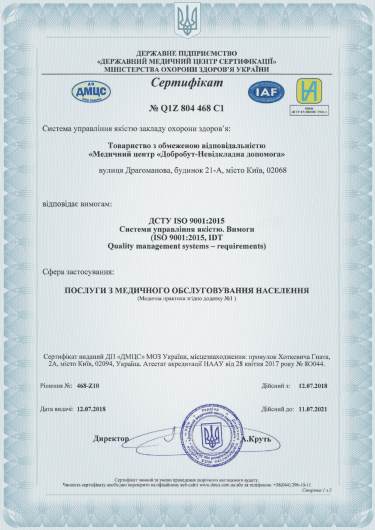
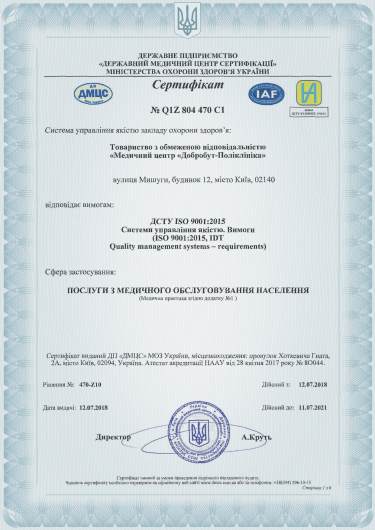
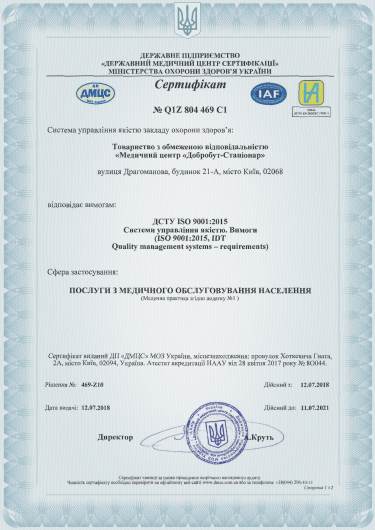
Accreditation certificates
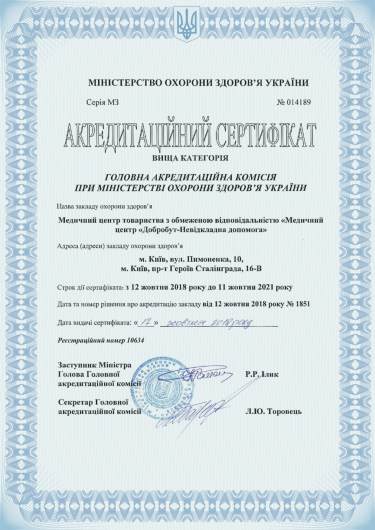
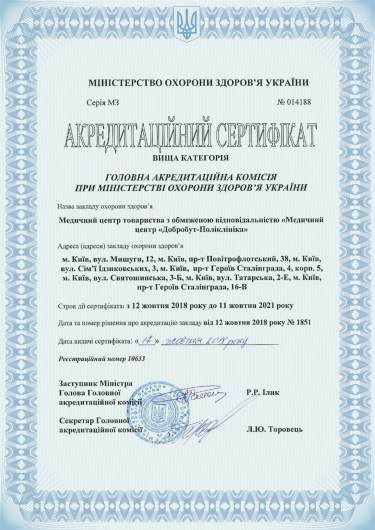
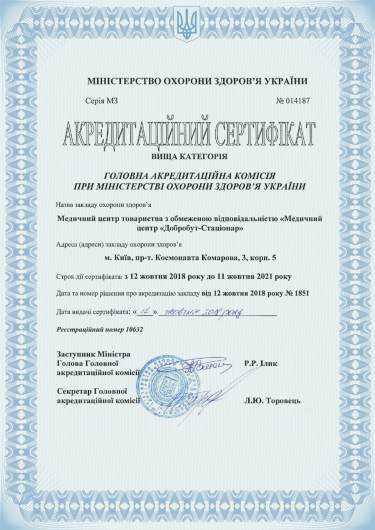
Medical practice licenses
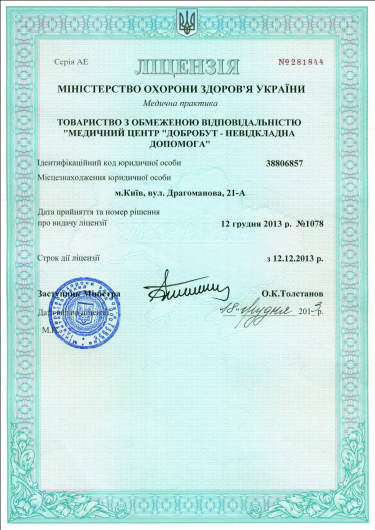
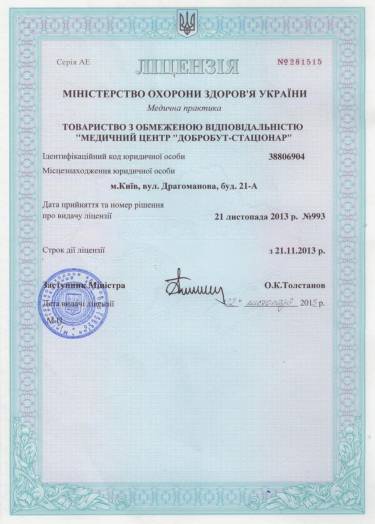
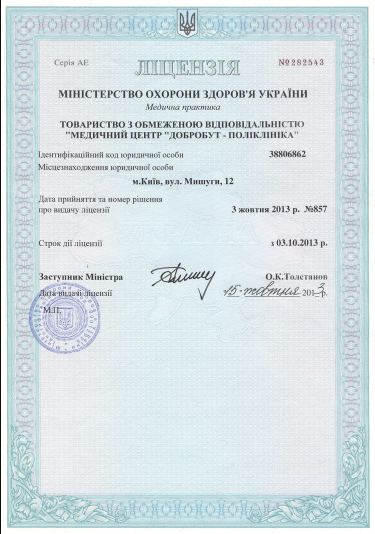











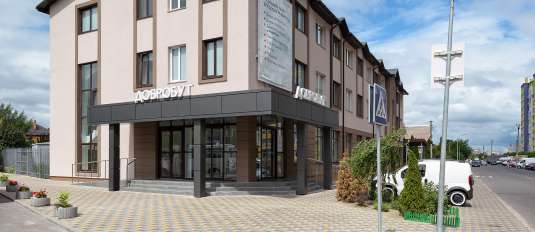
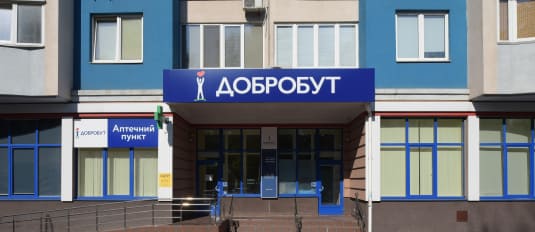

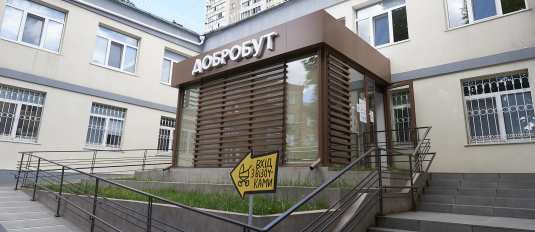




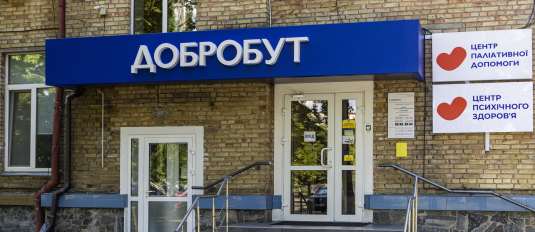
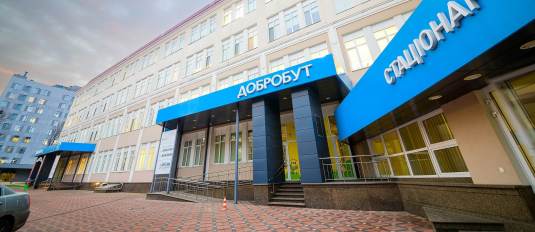
%402x.png)
%402x.png)
